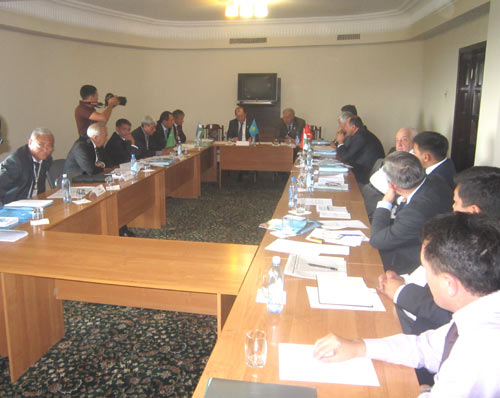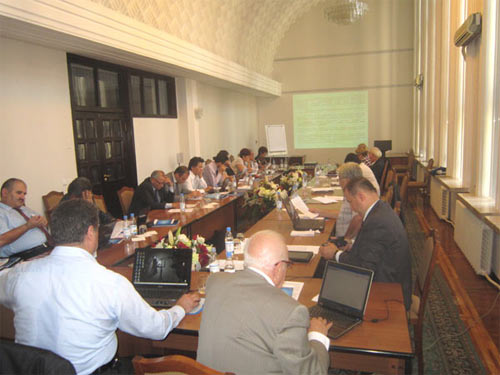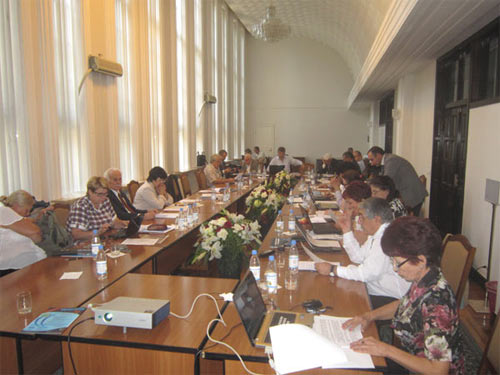60th REGULAR MEETING OF THE INTERSTATE COORDINATION WATER COMMISSION
The 60th regular meeting of the Interstate Coordination Water Commission (ICWC) was held on 17 February 2012 in Almaty.
The following items were entered to the agenda of the meeting:
1. About results of vegetation period 2012, operation modes of cascade reservoirs and limits on water withdrawals during non-vegetation period 2012-2013 in the Amudarya and Syrdarya river basins (responsible: BWO “Amudarya” and BWO “Syrdarya”).
2. Regarding agenda and venue of the next 61st ICWC meeting.

Appropriate decisions concerning all items of agenda were adopted.
Materials of this meeting will be published in the next ICWC bulletin which is planned to be issued on November 2012.
RESEARCH AND PRACTICE WORKSHOP «EXCHANGE OF INFORMATION AND KNOWLEDGE AND CAPACITY BUILDING IN THE WATER SECTOR OF EECCA»
The research-practice workshop «Exchange of Information and Knowledge and Capacity Building in the Water Sector of EECCA» was held in Almaty on the 19th of September 2012.
In total, 27 representatives of water-management organizations, research institutes, universities, and NGOs from Armenia, Georgia, Kazakhstan, Kyrgyzstan, Russia, Tajikistan, Turkmenistan, Uzbekistan, Ukraine, and Switzerland took part in this workshop.
The aim was to share experience in information exchange in the water sector of EECCA countries, identify problems, and develop recommendations for their solution.
The participants were presented an experience in developing water information systems and the principles of information dissemination.
The following reports were delivered:
Dukhovny V.A. (SIC ICWC, Uzbekistan, Executive secretary of NOW EECCA) The Network of Water Organizations in EECCA - our Present and Future.
Mukhamedjanov Sh.Sh. (SIC ICWC, Uzbekistan) About Activities of ICID Work Group on Irrigation and Drainage in the States under Socio-Economic Transformation.
Thalmeinerova D. (GWP, Sweden) Knowledge Management in GWP.
Sokolov V.I. (GWP, SIC ICWC, Uzbekistan) GWP CACENA’s Activities for Capacity Building in the Water Sector.
Sorokin D.A. (SIC ICWC, Uzbekistan) Water Management Models for Transboundary Rivers in the Aral Sea Basin: Application, Development, and Integration.
Shivaryova S.P. (RHC IFAS, Kazakhstan) Experience of Cooperation among Hydrometeorological Services in CA in the area of Information Exchange.
Prokhorova N.B. (RosNIIVH, Russia) Development of Scientific-Methodological Bases for Transboundary Water Management.
Omelianenko V.A. (NIA «Priroda», Russia) Experience in the Development of Water Information System in Russia.
Trophantchuk S.I. (Seversk-Donets BWMA, Ukraine) Transboundary Cooperation and Data Exchange in the Seversk Donets River Basin.
Bulekbayeva L.B. (Department for Water Resources and Land Reclamation, Kyrgyz Republic) Development of Water Information System in Kyrgyzstan.
Kobuliev Z.V. (Institute of Water, Hydropower, and Ecology, Academy of Sciences, Republic of Tajikistan) Development of Water Information System in Tajikistan.
Nurmukhammedova G. (Analytical Agency “Ynanch-Vepa”, Turkmenistan) State of Information Systems in Turkmenistan.
Abduraimov M.F. (NGO «Zeravshan River Basin Protection, Uzbekistan) Development of Water Information System in Uzbekistan.
Chkhobadze N. (National Water Partnership, Georgia) Development of Water Information System in Georgia.
Movsisyan G. (Scientific-Training Center for Environmental Law at YSU, Armenia) Development of Water Information System in the Republic of Armenia.
In Kyrgyzstan, the national information-analytical system is based on regulations of the Kyrgyz Water Code, Chapter 17 “The unified water information system”. The leadership of national water sector was among pioneers who recognized the benefits and advantages of developing a national information system for its use in daily work. A number of projects were implemented in different years with the support of donors under the auspices of the national water agency. This has resulted in the development of databases on various directions. The proposed information-analytical system should become a powerful tool supporting governance and development of the whole national water sector.
 In Tajikistan, the national information system for the most part is integrated with the regional IS of CAREWIB. At present, the national team is occupied in testing of the Aral Sea basin management model (ASBmm) developed by SIC ICWC with the support of IHE UNESCO.
In Tajikistan, the national information system for the most part is integrated with the regional IS of CAREWIB. At present, the national team is occupied in testing of the Aral Sea basin management model (ASBmm) developed by SIC ICWC with the support of IHE UNESCO.
In Turkmenistan, high-level officials of the country already raise the issue of regular information exchange between Turkmen agencies. This work is full-speed running in some agencies, including Statistics Committee, Ministry of Economy, and Strategic Planning Institute. Moreover, people start understanding the system of storage and comprehensive analysis of collected information using up-to-date technologies. Improvement of information storage and processing systems is of crucial importance in the short-term.
In Armenia, information support of the national water sector is provided by the Environmental Impact Monitoring Center at the Ministry of Nature Preservation. Information is provided on the web-site www.armmonitoring.am and in form of monthly and annual bulletins. The Center performs hydrochemical monitoring at 131 stations located along 39 rivers, in 6 reservoirs, and Sevan Lake.
In Georgia, such state organizations as the Agency for Nature Preservation (former “Hydromet”) at the Ministry of Environment and the Emergencies Agency at the Ministry for Foreign Affairs mainly deal with prevention and mitigation of disasters (floods, droughts). There is also a network of non-governmental organizations for disaster mitigation.

Activity of the Seversk-Donets Basin Organization (Ukraine) shows an excellent example of basin management. The information-advisory framework for water resources management - Decision-Support System (DSS) - established by the North Caucus branch of the Water Research Institute is used in the Seversk-Donets Basin Organization and the Don Basin Organization. This system includes such subsystems as “Hydrochemistry” (database on water quality) and “Water balances” (database on hydrology). An interstate data exchange system has been applied since 2006 between Russia and Ukraine to support decision making in water management within these states. The system enables flexible regulation of data sets received on:
- operation regimes of reservoirs, including small border ones;
- quality of water resources in border cross-sections;
- forecasts of flooding and flow conditions during low-water period;
- implementation of water measures affecting riparian party.
It was noted that the application of data exchange system, using modern data transmission methods, at the intra-state level enhanced timeliness and quality of information on transboundary water bodies within Kharkov, Donets, and Lugansk provinces in Ukraine. Development of information system in Ukraine progresses in conformity with the European Water Framework Directive.
The Federal Special-Purpose Program “Development of the water sector in Russia up to 2020” makes provision for advancing the information support in Russia that consists in the following:
- adoption of common legal mechanisms of environmental planning that should comply with the international law
- harmonization of standards in the area of nature conservation and natural resources use
- development of a single system of information exchange
- creation of databases on best environmental, resource-saving technologies and treatment systems and their regular updating.
The long-term objective of regional water cooperation in Central Asia should be ensuring environmental, food, and energy security through the balanced development, first of all, of water and energy sectors. The negotiation process is to aim at harmonizing the interests of water, energy and environmental spheres in connection with the national socio-economic development thrusts. However, low success rate of forecasts, lack of reliable information on river runoffs, water diversions, and return water in some reaches are destabilizing factors that further complicate the situation in the Aral Sea basin and lead to unjustifiable losses, shortages, irregular and unstable water supply to water-economic areas and to aquatic ecosystems in the basin. The problem is that decision makers do not have common tools for estimation and control that are based on agreed approaches to assessment of available water and to management of large reservoir hydrosystems and HPP cascades. For solution of those tasks the following was developed:
- Aral Sea Basin Economic Allocation Model (BEAM), jointly by DHI, COWI and Global Water Partnership CACENA on request of the Executive Committee of IFAS and USAID
- Integrated model of the Aral Sea Basin (ASBmm) by experts from UNESCO IHE and SIC ICWC.
Many experts think that exactly those models (adequately enhanced, adapted and tested) can solve important tasks on flow control in river basins at transboundary (interstate) level.
The main purpose of this pair - BEAM & ASBmm - in the future is the professional use of given tool for studies of alternative scenarios and for building of effective national development strategies in the region. At the same time, this package is aimed at wide circle of users. BEAM & ASBmm should become an element of the decision support subsystem , which is a part of the regional information system.
The common problems for EECCA countries are:
1) those voiced at the meeting of the ICID Working Group on Irrigation and Drainage in the States under Socio-Economic Transformation (63rd meeting of ICID Executive Committee, Adelaide, Australia, 24-29 June 2012).
- There is population growth along with sharp rise in prices of food related with water (i.e. with irrigation).
- By 2025, the whole south territory of the Earth would virtually suffer from water shortage.
In this context, ICID sets the following priorities and targets for the near future:
- Target I Increase rainfed land productivity
- Target II Increase water productivity in irrigated agriculture
- Target III Increase sustainable productivity and lower costs of water management such that by 2025 there is food security at acceptable prices for all
- Target IV Safe use of non-conventional waters in agriculture and aquaculture
- Target V Water storage in support of irrigated agriculture
- Target VI Personal visions
- Target VII Groundwater
- Target VIII Food supply chain efficiency
- Target IX Support to small-holder farmers
2) those set in the presentation of Prof. V.A.Dukhovny, Executive Secretary of NWO EECCA:
- Changes in global water situation since 1997 to 2012:
- General water consumption increased by 550 billion m3;
- Water shortage (less than 1000 m3/person) affected 1.4 billion people as compared to 0.5 billions in 1990;
- Irrigation areas decreased by 12 Mha - 5 % of the total irrigation;
- Number of starving population increased from 850 to 1020 millions;
- 2 billion people do not have access to sanitation;
- Negative consequences of floods have grown dramatically.
- Major challenges in the EECCA region:
- Climate change impact: reduced runoff, melting of glaciers, prevalence and intensification of extreme phenomena;
- Demographic pressure – growth of population: 1.2-1.8% per year;
- Weak economic base;
- Poor water management;
- Hydro-egoism;
- Current restructuring of economy, particularly of irrigated agriculture;
- Market and price volatility;
- Lack of political attention.
It was underlined that the region has developed its own vision of IWRM, which includes:
- Multilevel water management system supported by appropriate governance system;
- Set of institutional, legal and engineering measures;
- Combination of state path with powerful community initiatives.
The main IWRM principles include:
- Water resources management within hydro-geographic boundaries;
- Use of all sources (surface water, groundwater, and return water);
- Close coordination of all water users and organizations;
- Public participation both in management of water resources and in financing, planning, and development of water infrastructure;
- Setting of ecosystem demand’s priority;
- Water saving and control of non-productive losses;
- Information exchange, openness and transparency of water management system;
- Economic and financial sustainability of water-management organizations.
Finally, the participants made the following conclusions.
CONCLUSIONS:
1. The participants of the joint workshop of EECCA Network and GWP CACENA shared information about progress in cooperation among the partners in the field of water sector improvement in our regions.
2. Water sectors in all the countries show positive developments towards improved water supply and sanitation, especially in the urban sector, mainly at the expense of IFI loans. An importance of IWRM was recognized but also IWRM principles were developed specifically for conditions of the region, where irrigated agriculture prevails, and being implemented successfully on the vast areas in Central Asia, Ukraine and in Azerbaijan.
3. At the same time, in general, current water governance and management do not meet present requirements and need to be improved radically, as well as require significant efforts of both state and community actors. In this context, activities of GWP CACENA and EECCA Network need to be intensively developed and supported in part of:
- Dissemination of appropriate governance and management principles in context of IWRM;
- Enhancement of information exchange, with focus on dissemination of knowledge and best practices accumulated in the region;
- Organization of training in the main directions that lead to improved water sector functioning (IWRM, water use technologies, IS application, international water law) in form of both training workshops and distant learning (“e-learning”);
- Development of knowledge centers (regional and national) aimed to assist water users at different levels of water hierarchy;
- Involvement of organizations of water profile, especially research institutions, and regular communication of R&D results for their application in practice for efficient water use and protection.
4. It is necessary to attract basin organizations in EECCA Network and enhance exchange of information on activities of lower level organizations.
5. The participants thanked RFBR (Russian Foundation for Basic Research), UNECE, and GWP CACENA for the provided financial support that allowed publishing 4 collections of scientific papers, maintaining the Network’s web-site www.eecca-water.net, and organizing annual meetings, including the workshop in Almaty. At the same time, it was noted that the size of this support obviously is not enough for wider involvement of the Network’s members in regular activities. The same concerns attention of INBO to EECCA Network operation.
|